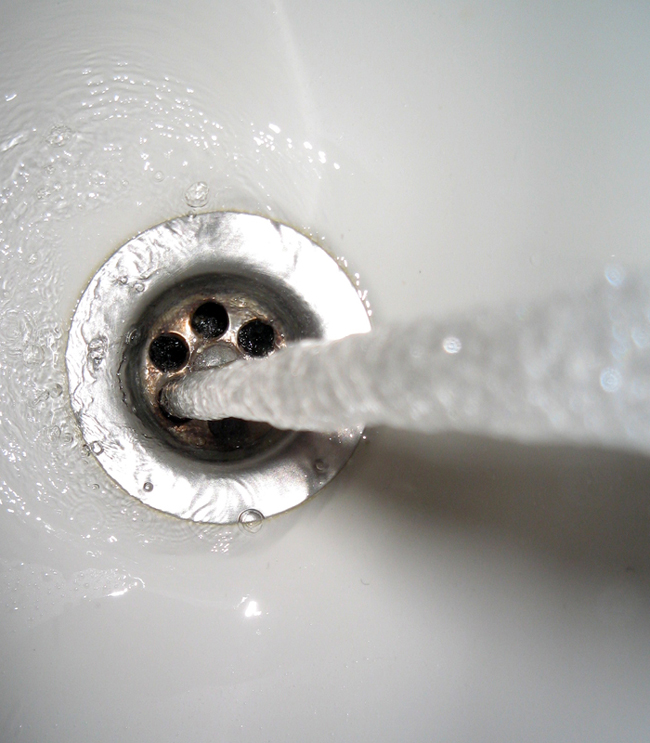Two Kinds of Liquids to Fix a Clogged Drain
| . Posted in plumbing, repairs - 53 Comments

Image of a drain by Sissel Karlsen
Lye
Lye, known to scientists as “sodium hydroxide,” is an extremely caustic base. Remember high school chemistry? Bases are the opposite of acids, but just as powerful at dissolving things like hair, grease, and bits of food.
Commercial formulations of lye include extra stuff to make it work faster and more safely. For instance, Drano contains a mixture of lye, aluminum flecks, and sodium nitrate. Some of the lye reacts with the aluminum and gets hot, which increases the effect of the rest of the lye on the grease in the drain. When the lye dissolves the grease, it releases explosive hydrogen. This could detonate your drains, except the hydrogen gets safely absorbed by the sodium nitrate.
The pros of lye are that it’s effective against sticky clog-smears like what you find in kitchen sinks, as well as thick hair clogs in bathrooms. The solution is denser than water, so you can pour it right into standing water and it will sink.
Note that to use lye effectively, you need to raise any stoppers that might be in place (duh, but no really, check this, especially in tubs) and pour in enough of it to fill and bypass the P-trap. The parts that clog are often the P-trap or the slow-running horizontal just past it.
There are three cons to using lye.
First, lye is extremely dangerous. Use latex or rubber nitrile gloves and chemical goggles, or else be extremely careful about drips and splashing. Do not use lye while eating, smoking, or with a runny nose unless you take off your gloves and wash your hands before you touch your face. Never leave it within reach of children or pets.
Second, lye can get so hot that it boils the drain water. This may create aggressive bubbling or splashing in the sink or tub. If you have a spare bucket, turn it upside-down over the drain after you lye it. If there is a lot of standing water, the water may act as enough of a damper, or you may wish to start slow and pour only as much lye as needed. If you lye a garbage disposal, do not run the disposal until the water has settled.
Third, lye dissolves toilet wax rings. You cannot use lye in a toilet without creating a leak. You may not see it, but the leak will be there. Toilets must be plunged or snaked. If the toilet is backed up because of a clog below the wax seal, then depending on your plumbing configuration you could theoretically insert the lye into an upstream sink or tub and wait for the lye to work its way down past the toilet to the main clog. But most likely, such a clog would be noticeable as a sink or tub clog before you see it in the toilet.
Bacteria
The second kind of liquid assistance is called “build-up remover,” and it’s actually less of a “chemical” and more of a “biological.” Buildup removers are solutions of bacteria or biological enzymes that eat or dissolve the crud stuck to your pipes. They then get washed downstream. Bacterial cleaners are mixed with propylene glycol, which is the same liquid used to de-ice planes, and it’s the same as the “juice” people vape.
Compared to solutions of lye, bacterial drain cleaners are safer. They require less eye and skin protection. But you still should be careful not to ingest or splash the product.
Buildup removers are better used as a preventative on a regular basis than as a clog-fixer. They can dislodge wall coatings and create clogs. If this happens, pour hot water down the drain and it should loosen. You may need to alternate bacteria with lye to clear a neglected drain.
In conclusion, tough clogs need a combination of chemicals centered around lye as the main ingredient. Slow running and constricted drains can be moved along with periodic bacterial rinses. Always wear safety equipment, follow instructions on the label, and be patient. Good luck!
Members can search our service provider director for drain cleaning (a separate skill from plumbing) to get your building back in service.




